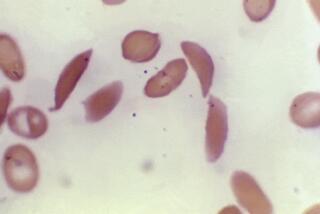Eugene Goldwasser dies at 88; biochemist was known for anemia drug
Eugene Goldwasser, the biochemist who isolated and purified the anti- anemia protein erythropoietin — arguably the most important biological drug since insulin — died Friday at his home in Chicago of kidney failure associated with prostate cancer. He was 88.
Erythropoietin, commonly known as EPO, was one of the first blockbuster drugs of the biotechnology industry and was the foundation for the success of Amgen of Thousand Oaks. Yet neither the University of Chicago, where Goldwasser isolated the drug, nor the National Institutes of Health, which funded his work, chose to patent the discovery, and Goldwasser himself never got around to it.
“One percent of 1% of the drug’s annual revenues would have funded my lab quite handsomely,” he later reflected.
But he took immense satisfaction in the fact that the drug allowed millions of dialysis patients and anemic patients with other diseases or those undergoing chemotherapy to live longer and more productive lives. “The enormous success of EPO still astonishes me,” he wrote in a 1996 biographical essay. “It is still gratifying to me to see how effective EPO is in correcting the anemia of dialysis patients, and how it spares them repeated transfusions.”
His primary regret was the abuse of the drug by athletes, particularly bicycle racers, who injected it to increase their endurance. In 1998, a third of the cycling teams in the Tour de France were expelled or withdrew in an EPO-doping scandal.
Researchers had long known that something in the blood stimulated the production of red blood cells and had even named it, but EPO was present in such low concentrations that they had immense problems isolating it. In 1955, young Goldwasser was asked by his mentor Leon O. Jacobson to look for it.
“I thought it would be an easy problem to solve,” he later said. “Six months it would take, I thought. It actually took 20 years. I’m stubborn.”
He began by removing various organs from rats, trying to determine which one produced it. He struck pay dirt when the removed the kidneys, which explained why people with chronic kidney disease become anemic. It also suggested that EPO could be found in urine.
By 1971, he and his colleagues had purified 6 millionths of a gram of EPO from 125 gallons of plasma from anemic sheep, and they turned their attention to humans. A Japanese colleague, Dr. Takaji Miyake, had suggested that EPO could be found in the urine of patients suffering from aplastic anemia.
According to the book “The $800 Million Pill” by Merrill Goozner, on Christmas Day of 1975, Miyake met Goldwasser in the lobby of the Palmer House hotel in Chicago and presented him with a brightly wrapped package containing the concentrate from about 675 gallons of urine from his patients. From that urine, the team isolated about 3 ten-thousandths of an ounce of EPO, enough for a few tests.
Several companies sought Goldwasser’s attention, but he chose Amgen. There, geneticist Fu-Kuen Lin used a tiny amount of the sample to clone the gene for EPO, inserting it into hamster cells and producing enough of the protein for it to be sold as a drug. Within a year, the company was selling more than a billion dollars’ worth of the drug annually, and dialysis patients who had been so weak from anemia that they were crawling up stairs were living normal lives.
Eugene Goldwasser was born Oct. 14, 1922, in Brooklyn. His father owned a small clothing manufacturing business but was forced to close it during the Depression, and the family moved to Kansas City, where young Goldwasser’s uncle ran a similar business.
He won a scholarship to the University of Chicago, where he majored in biological sciences. After World War II began, he worked in the university’s Toxicity Laboratory, a federally funded program to assess chemical and biological risks. After his graduation in 1943, he was drafted into the Army and spent two years at Ft. Detrick in Maryland working on a vaccine against anthrax.
At war’s end, he returned to the University of Chicago, receiving his doctorate in biochemistry in 1950. He stayed there for the rest of his career, retiring in 2002.
His friends recalled him as an avid and gifted photographer, sailor, traveler and, in his younger years, skier.
His first wife, the former Florence Cohen, died in 1981. He is survived by his second wife, the former Deone Jackman; three sons, Thomas of San Francisco, Matthew of Chicago and James of New York; two stepchildren; and seven grandchildren.
More to Read
Start your day right
Sign up for Essential California for the L.A. Times biggest news, features and recommendations in your inbox six days a week.
You may occasionally receive promotional content from the Los Angeles Times.






